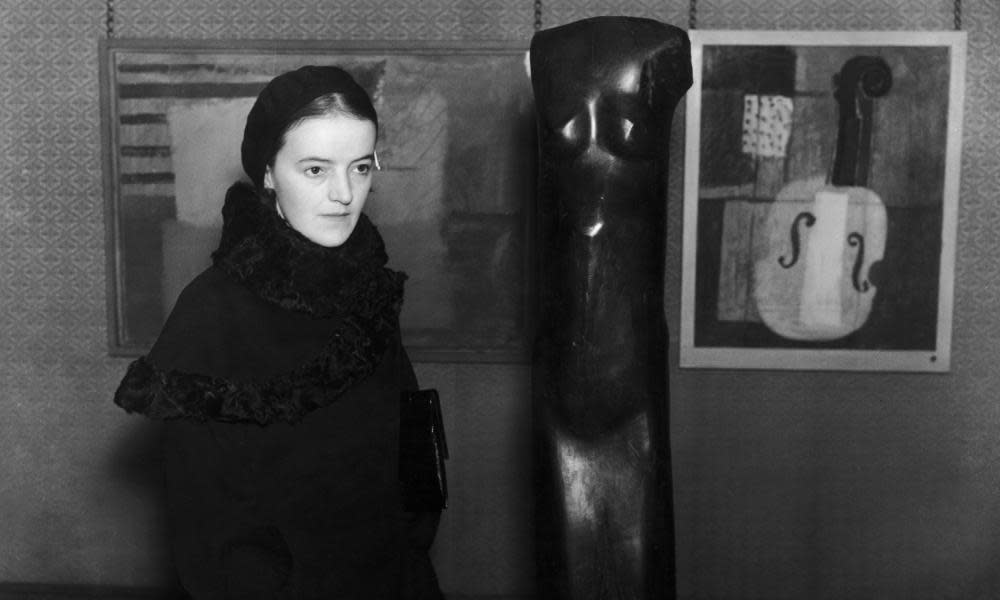Circles and Squares by Caroline Maclean review – Hampstead's brave and brilliant souls

Artists, wrote the critic Myfanwy Evans in 1937, were in the middle of a thousand battles: “Hampstead, Bloomsbury, surrealist, abstract, social realist, Spain, Germany, heaven, hell, paradise, chaos, light, dark, round, square.” It’s a line that sums up the argumentative world that is the subject of Circles and Squares, one that was ambitious, international and parochial all at once.
Hampstead and Bloomsbury, it will be noted, are put in the same class of opposition as heaven and hell: different stops along London Transport’s number 24 bus route are compared with the opposing polls of divine cosmic order. Bloomsbury was a slightly older centre of the English avant garde. Hampstead, in the 1930s, attracted a loose group of makers and thinkers who did their best to plant a version of the modernism that had sprung up in continental Europe a decade earlier.
British soil had proved hostile to such a thing, so the likes of Barbara Hepworth, Ben Nicholson and Henry Moore, with the support of critics such as Herbert Read, strove to develop and promote a form of abstraction that, while inspired by Picasso and Mondrian, was also British. The common aim was to create both art and a way of living that was modern, spiritual and unencumbered. “We cannot burden ourselves with permanent tangible possessions,” said the architect Wells Coates, when we have “our real new possessions of freedom, travel, new experience – in short, what we call life”.
There were writers in the neighbourhood, including Louis MacNeice and WH Auden, as well as artists. There were the courageous patrons Jack and Molly Pritchard, who commissioned the Isokon apartment building, designed by Coates as a kind of ark of futuristic life. Sometimes the art gods whom these Hampstead modernists worshipped would pay them visits from other countries: Walter Gropius, Piet Mondrian, Georges Braque, Marcel Breuer, László and Lucia Moholy-Nagy. Virginia Woolf, of local rivals the Bloomsbury group, dropped by. Read called her “remarkable, but the cattiest woman I have ever known”.
Caroline Maclean arranges her account around these individuals and couples. She frames it with Hepworth and Nicholson, who at the start of the decade are leaving their previous marriages for each other and at the end are fleeing from the impending blitz, along with their triplet children, to Cornwall. In the years between there is much creating and much theorising. Groups and magazines are launched, exhibitions held and efforts made to engage the public via a press that is often indifferent or dismissive. “At best a jolly leg-pull,” said the Daily Mail of a show that included Calder, Giacometti and Mirò.
Some fun is had. Members of the Half Hundred Club, dedicated to “good and imaginative dining with economy”, eat bison tail and silverside of antelope in the grounds of London Zoo. Tennis is played. Ben Nicholson gets Slazenger interested in a variant of ping-pong that he has invented, but it comes to nothing. Money is often scarce, home comforts suboptimal, inventive improvisation required. People dance to jazz records. People sleep with people who are married to someone else, get married to each other, and then sleep with some other people. Part of the reason for simplifying life in other ways, it seems, was to allow time for complicated affairs.
At its best, this is a story of brave and sometimes brilliant souls defying convention to live and work as they wish. Hampstead in the 30s did indeed germinate some great art and a lot of good art. It championed work that almost no one would buy that is now at the centre of museum collections all over the world. Barbara Hepworth, as someone quietly committed to her sculpture, comes across well. So, although we don’t get enough of him, does the surrealist artist and collector Roland Penrose, who knew how to have a good time.
At its worst, 30s Hampstead was a tepid version of its European inspirations, a bit mimsy and mithering, its disputes and debates somewhat petty. I wish that Maclean’s book did more to change that perception, but she doesn’t give much direction or insight to her material, which therefore reads as a succession of anecdotes. Some are fabulous, others are not (“Irina remembered making jam and being swarmed by wasps”). Which is a shame: at the very least this was an exceptional bunch of people, who deserve a more illuminating treatment than they get here.
• Circles and Squares: The Lives and Art of the Hampstead Modernists by Caroline Maclean is published by Bloomsbury (£30). To order a copy go to guardianbookshop.com. Free UK p&p over £15


